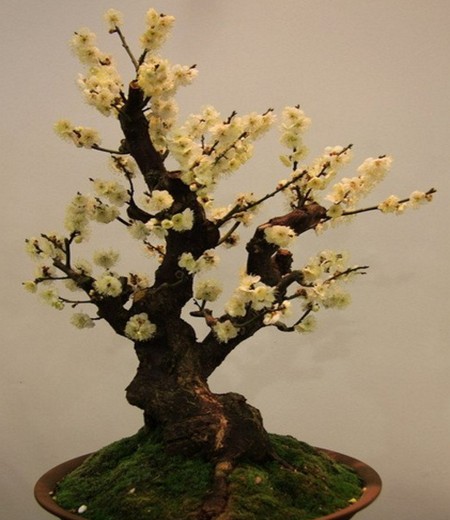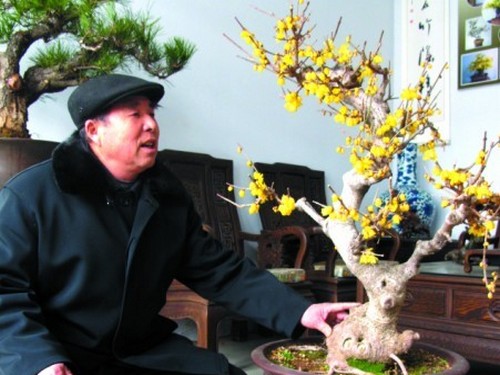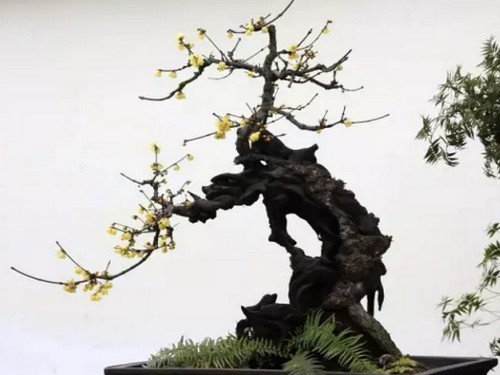Pruning technique of preserved plum bonsai
Chimonanthus has strong branching power, and it is known as the proverb "Chimonanthus does not lack branches". It can sprout more strong flower branches and blossom more through pruning at the right time. It is generally appropriate to prune the withered branches, overdense branches, cross branches, disease and insect branches, and leave 2 to 3 pairs of buds at the base of the annual branches, and cut off the upper branches to promote the germination and branching. After the new branch grows to 2 to 3 pairs of leaves, it is necessary to pick the heart to promote the germination of short and strong flower branches and make the plant shape symmetrical and graceful. Pruning is mostly carried out from March to June and stops after July. If it is not pruned during the suitable period, many branches will be drawn out and nutrients will be consumed, resulting in little differentiation of flower buds and affecting flowering.

Pruning and sprouting are very important to make Wintersweet blossom year after year. Pruning usually takes place from March to June and stops after August. The old flower branches should be truncated immediately after flowering each year, leaving a maximum length of only 15cm to 20cm. After the new branch grows 2-3 pairs of buds, the terminal bud is removed, and soon the side branch grows again. After growing to 10 cm, the bud is picked again and repeatedly several times until the flower bud is basically formed. It is also necessary to prune all kinds of cross branches, parallel branches, overlapping branches, opposite branches, long branches, and overdense and thin branches that affect the appearance of the tree. It is said that there is no shortage of branches in the flower proverb, so the wax plum can be re-cut.
Jingling Plum Garden, a park designed with the theme of Chimonanthus, tens of thousands of Wintersweet are cultivated in the park. Chimonanthus commodity value to bonsai Chimonanthus outstanding income. Bonsai Chimonanthus pruning focuses on the coordination of the overall shape and unique conception. Chimonanthus pruning is a technical work, thinning and cutting need to cut off some "taboo branches". How to avoid branches, what are the types of taboos? Qianling County Jingzhiyuan Flower and Tree Information Technology Co., Ltd., the vast number of seedling farmers made the following summary:
Taboo branches are mainly divided into the following types:
Ventral branch: a branch that grows from the curved inside of a stem. If there is a good branch nearby, cut it off from the root.
All kinds of taboo branches of Wintersweet bonsai pruning
Crossed branches: branches that cross each other, cut off, or correct with wire.
Reverse branch: to extend to the root of a branch, cut off, or correct with wire.
Standing branch: too strong to disturb the shape of the tree, cut off.
Falling branches: (downward branches) not only have no momentum, but also disrupt the tree and cut off.
Wheel branch: a branch that extends in more than three directions at the same position of the stem, which thickens the stem at that position. Leave one and cut off the others.
Parallel branches: not parallel to the left and right, but in a similar position, grow two branches in the same direction, choose one to keep the branches smooth, cut off.
Protruding branch: the back branch is very important, but the front branch should at least not let it grow in the lower part, but leave a short part in the upper part, so that you can appreciate the beauty of the stem and make people feel like a big tree.
Concave branch: a branch that grows not in a V shape but in a U shape. If it's thicker, cut it off.
Through branches: extend in both directions as if through the stem, choosing one side to cut off.
Axillary branches: also known as stacked branches, adventitious buds growing from the roots of branches, cut off.
For the formed wintersweet bonsai, pruning and shaping should be carried out in time after the flower fade to cut off part of the perennial branches and promote the branches to sprout small lateral branches again. The aged branches can also be re-cut according to the shape of the tree to facilitate their renewal and rejuvenation, but pay attention to the position and direction of the terminal buds on the remaining branches. During the growing period, attention should be paid to the new twigs in the current year, so as to promote more branches, change the direction of the branches, make the branches grow stout, breed more buds and blossom more. In the growing season, for some new branches that need to be bent, hemp rope or brown rope can be used to pull properly, and the necessary pruning should be carried out according to the nature and growth of the tree. After the beginning of autumn, when the flower buds grow to the size of rice grains, a pruning and shaping is carried out to control the excessive growth of branches, so that the plant is compact and the tree shape achieves the artistic effect of sparse shadow and horizontal slope, and it is convenient for the plant to accumulate nutrients and make its flowers large and colorful.
Time: 2019-06-12 Click:
- Prev

Modeling methods and principles of preserved plum bonsai
There are many ways of modeling of Lamei bonsai. Take Sichuan School of Bonsai as an example, they make Lamei bonsai, which is mainly shaped by rolling dragons, and is characterized by potential such as dragon flying and Phoenix dancing. If you want to keep the shape of the tree, wait for the new branches to grow; if you do the pile scene, cut off the direct branches and shape again after the new branches come out in the coming year.
- Next

Modeling method of Chimonanthus bonsai
In Jingling, Henan Province, the hometown of Chimonanthus, the traditional bonsai forms of Chimonanthus include single plum, dragon plum, pimple plum, single hanging plum, double hanging plum, round hanging plum, screen fan plum, pearl inverted rolling curtain and so on. It can not only be modeled with young trees, but also can be used as rootstocks with old and simple ancient piles of Chimonanthus chinensis.
Related
- Fuxing push coffee new agricultural production and marketing class: lack of small-scale processing plants
- Jujube rice field leisure farm deep ploughing Yilan for five years to create a space for organic food and play
- Nongyu Farm-A trial of organic papaya for brave women with advanced technology
- Four points for attention in the prevention and control of diseases and insect pests of edible fungi
- How to add nutrient solution to Edible Fungi
- Is there any good way to control edible fungus mites?
- Open Inoculation Technology of Edible Fungi
- Is there any clever way to use fertilizer for edible fungus in winter?
- What agents are used to kill the pathogens of edible fungi in the mushroom shed?
- Rapid drying of Edible Fungi

